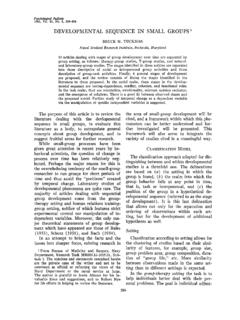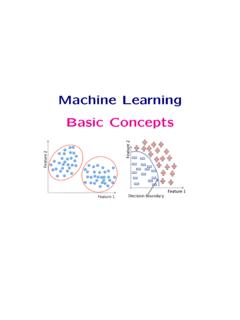Transcription of Using LSTM in Stock prediction and Quantitative Trading
1 Using LSTM in Stock prediction and QuantitativeTradingZhichao ZouCenter for Professional DevelopmentStanford UniversitySUNetID: QuCenter for Professional DevelopmentStanford UniversitySUNetID: direction of the financial market is always stochastic and volatile and thereturn of the security return is deemed to be unpredictable. Analysts now aretrying to apply the modeling techniques from Natural Language Processing intothe field of Finance as the similarity of having the sequential property in the this research, we have constructed and applied the state-of-art deep learningsequential model , namely Long Short Term Memory model (LSTM), Stacked-LSTM and Attention-Based LSTM, along with the traditional ARIMA model , intothe prediction of Stock prices on the next day.
2 Moreover, Using our prediction ,we built up two Trading strategies and compared with the benchmark. Our inputdata not only contains traditional end-day price and Trading volumes, but alsoincludes corporate accounting statistics, which are carefully selected and appliedinto the models. The accounting data are regarded as the news and price shocks to acorporation, hence are expected to increase the predictive power of the model . Theresult has shown that Attention-LSTM beats all other models in terms of predictionerror and shows much higher return in our Trading strategy over other , we discovered that the stacked-LSTM model does not improve thepredictive power over LSTM, even though it has more complex model IntroductionIn the field of Quantitative Trading , predicting the future security returns lies in the center of the indus-try, as the future Trading strategy is always deployed and created based on our view of the financialmarket in the future.
3 The Trading area has two main different methods, namely fundamental analysisand Quantitative Trading . Fundamental method makes the Trading decision based on the subjectiveview on the industry or company s future direction, it mainly relies on the public information suchas market news, corporate statistics as well as a series of financial statement releases. On the otherhand, the Quantitative Trading strategy uses mathematical models to make the decision hence avoidsthe interruption of human subjectivity and emotion. Traditionally, the methodology of quantitativestrategy involves Using linear regressions, ARIMA model as well as GARCH model to capture thefeatures of time series and the stochasticity of the volatility.
4 These methods were proved to beeffective for a certain period of time in the old regimes. As the regime shift happens in the financialindustry, these models became less effective. The Quantitative Trading industry has therefore shiftedinto the deep learning era , which has been more frequently used this research, wepredicted stocks return Using the deep learning model , more specifically LSTM and Attention-LSTM models. Conventional financial time series prediction only uses price and volume to predict the futureCS230: Deep Learning, Winter 2020,prices. In this work, the input includes the usual price and volumes, as well as the corporate these statistics are released quarterly by the companies and have significant impacts on futureprice movements.
5 The output of our model is the price or scaled price on the next day. Once thefuture price is predicted, we will build up a Quantitative Trading strategy based on the prediction . Thereturn of our strategy is compared with the Related WorkDuring the pre-deep learning era, Financial Time Series modelling has mainly concentrated in thefield of ARIMA and any modifications on this, and the result has proved that the traditional timeseries model does provide decent predictive power to a limit. For example, due to the asymmetricdistribution in financial time series return, Minyoung Kim has replaced the traditional MaximumLikelihood Estimation with an asymmetric loss function.[7] Lee et al. compared the forecastingperformance of ARIMA and artificial neural networks on Korean Stock price index.
6 The workshowed that ARIMA provided more accurate forecasts than the back-propagation neural network.[8]More recently, deep learning methods have demonstrated better performances thanks to improvedcomputational power and the ability of learning non-linear relationships enclosed in various financialfeatures. Sreelekshmy Selvin et al. compared three different deep learning architectures includingRNN, LSTM, and CNN-sliding window models for the prediction of NSEI listed stocks.[11] Theyconcluded that CNN architecture is capable of identifying changes in trend of stocks and outperformsother models. Yan and Ouyang combined the wavelet transform of the financial time series withthe LSTM and showed that the resulting model beat the performance of traditional Support VectorMachine, and K-nearest Neighbours.
7 [12] Thien Hai Nguyen et al. demonstrated that the integrationof sediment features extracted from social media can improve the accuracy of prediction .[10] Theperformance of LSTM-RNN will be further boosted by feeding relevant data based on financialdomain knowledge. [3,5] Moreover, Kim Won has developed a hybrid approach to combine LSTMand GARCH models and the resulting model has much lower prediction errors. [6]3 Dataset and FeaturesThe data we utilized to train/develop and test our model include two aspects: 1. The daily pricesand volumes for every SP 500 Stock from 2004 to 2013. 2. The accounting and corporate statisticsfor the SP 500 stocks from 2004 to 2013. Two sets were merged by date and forward filled missingstatistics between two releasing date.
8 After large number of iterations in selecting the appropriateinput, the input we use are adjustment close price , Trading volume , Debt-to-Equity Ratio , Returnon Equity , Price-to-Book ratio, Profit Margin , Diluted Earnings Per Share and Company Beta .We applied the min-max scale to normalize the data between 0 and 1, hence prevent the magnitudeof certain features overwhelms others. For each Stock in SP 500 we have the daily data mentionedabove from 2004 to 2013. We use the approximate ratio of 70-15-15 to split the data for each Stock intraining, development, and testing data. In other words, we use data from 2013 to 2011 as trainingdata, 2012 as development data and 2013 as testing data. Our performance metrics and tradingstrategies are hence built on the data on 2013.
9 A sample piece of our data is shown Figure 1: Data structure of Google Stock price and corporate accounting statistics, from 2004 to 20134 MethodsIn order to examine the impact of predictive powers in different financial Time Series, we built threedeep learning models as well as one traditional time series model . They are 1) Time Series model (ARIMA);2) RNN with LSTM model (LSTM); 3) RNN with Stacked-LSTM (Stacked-LSTM);4)RNN with LSTM + Attention (Attention-LSTM).2 Time Series model :AutoRegressive Integrated Moving Average (ARIMA) model is a widely usedstatistical method for time series forecasting (equation 1). In this work, we followed the Box-JenkinsMethodology to build an ARIMA model as a baseline to compare with Deep Learning models.
10 [4]For the ARIMA model , only adjusted close price was used to fit the model . We used summarystatistics and functions such as moving average and autocorrelation function to identify data trendsand the parameters (p, d, and q) of ARIMA model . Yt(p,d,q) = + pp=1( p Yt p) pq=1( q et q)where Yt=Yt Yt d(1)RNN with Single/Stacked-LSTM:The main idea of RNN is to apply the sequential observationslearned from the earlier stages to forecast future trends. Long-Short Term Memory (LSTM) model isan updated version of RNN. It can overcome the drawback of RNN in capturing long term introduces the memory cell that enables long-term dependency between time lags. Thememory cells replaces the hidden layer neurons in the RNN and filters the information through thegate structure to maintain and update the state of memory cells.










![arXiv:1411.1784v1 [cs.LG] 6 Nov 2014](/cache/preview/f/a/6/8/3/a/5/7/thumb-fa683a5739b507f70aa173f9c218eee1.jpg)

